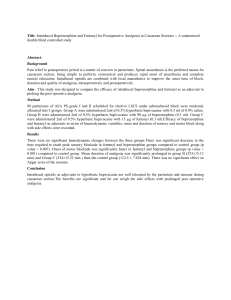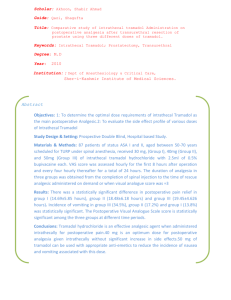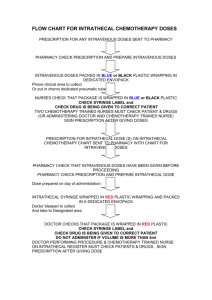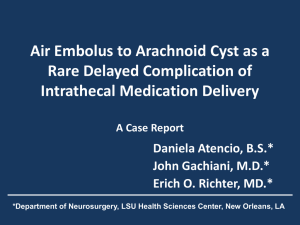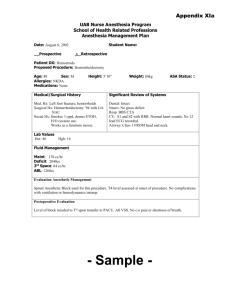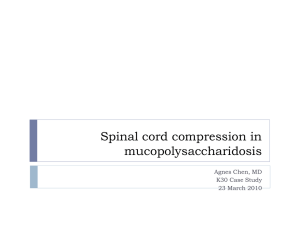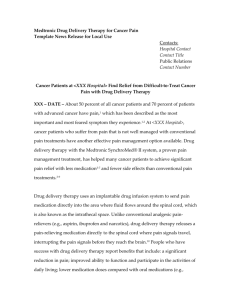Intrathecal Hydromorphone for Postoperative Analgesia After
advertisement
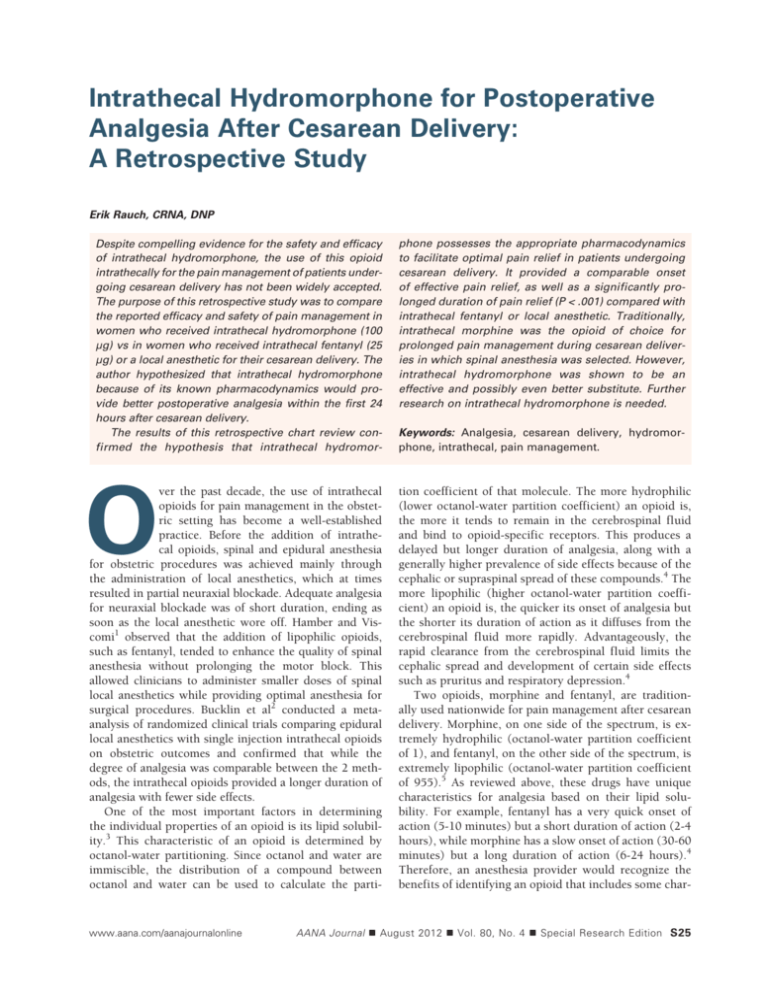
Intrathecal Hydromorphone for Postoperative Analgesia After Cesarean Delivery: A Retrospective Study Erik Rauch, CRNA, DNP Despite compelling evidence for the safety and efficacy of intrathecal hydromorphone, the use of this opioid intrathecally for the pain management of patients undergoing cesarean delivery has not been widely accepted. The purpose of this retrospective study was to compare the reported efficacy and safety of pain management in women who received intrathecal hydromorphone (100 μg) vs in women who received intrathecal fentanyl (25 μg) or a local anesthetic for their cesarean delivery. The author hypothesized that intrathecal hydromorphone because of its known pharmacodynamics would provide better postoperative analgesia within the first 24 hours after cesarean delivery. The results of this retrospective chart review confirmed the hypothesis that intrathecal hydromor- O ver the past decade, the use of intrathecal opioids for pain management in the obstetric setting has become a well-established practice. Before the addition of intrathecal opioids, spinal and epidural anesthesia for obstetric procedures was achieved mainly through the administration of local anesthetics, which at times resulted in partial neuraxial blockade. Adequate analgesia for neuraxial blockade was of short duration, ending as soon as the local anesthetic wore off. Hamber and Viscomi1 observed that the addition of lipophilic opioids, such as fentanyl, tended to enhance the quality of spinal anesthesia without prolonging the motor block. This allowed clinicians to administer smaller doses of spinal local anesthetics while providing optimal anesthesia for surgical procedures. Bucklin et al2 conducted a metaanalysis of randomized clinical trials comparing epidural local anesthetics with single injection intrathecal opioids on obstetric outcomes and confirmed that while the degree of analgesia was comparable between the 2 methods, the intrathecal opioids provided a longer duration of analgesia with fewer side effects. One of the most important factors in determining the individual properties of an opioid is its lipid solubility.3 This characteristic of an opioid is determined by octanol-water partitioning. Since octanol and water are immiscible, the distribution of a compound between octanol and water can be used to calculate the parti- www.aana.com/aanajournalonline phone possesses the appropriate pharmacodynamics to facilitate optimal pain relief in patients undergoing cesarean delivery. It provided a comparable onset of effective pain relief, as well as a significantly prolonged duration of pain relief (P < .001) compared with intrathecal fentanyl or local anesthetic. Traditionally, intrathecal morphine was the opioid of choice for prolonged pain management during cesarean deliveries in which spinal anesthesia was selected. However, intrathecal hydromorphone was shown to be an effective and possibly even better substitute. Further research on intrathecal hydromorphone is needed. Keywords: Analgesia, cesarean delivery, hydromorphone, intrathecal, pain management. tion coefficient of that molecule. The more hydrophilic (lower octanol-water partition coefficient) an opioid is, the more it tends to remain in the cerebrospinal fluid and bind to opioid-specific receptors. This produces a delayed but longer duration of analgesia, along with a generally higher prevalence of side effects because of the cephalic or supraspinal spread of these compounds.4 The more lipophilic (higher octanol-water partition coefficient) an opioid is, the quicker its onset of analgesia but the shorter its duration of action as it diffuses from the cerebrospinal fluid more rapidly. Advantageously, the rapid clearance from the cerebrospinal fluid limits the cephalic spread and development of certain side effects such as pruritus and respiratory depression.4 Two opioids, morphine and fentanyl, are traditionally used nationwide for pain management after cesarean delivery. Morphine, on one side of the spectrum, is extremely hydrophilic (octanol-water partition coefficient of 1), and fentanyl, on the other side of the spectrum, is extremely lipophilic (octanol-water partition coefficient of 955).5 As reviewed above, these drugs have unique characteristics for analgesia based on their lipid solubility. For example, fentanyl has a very quick onset of action (5-10 minutes) but a short duration of action (2-4 hours), while morphine has a slow onset of action (30-60 minutes) but a long duration of action (6-24 hours).4 Therefore, an anesthesia provider would recognize the benefits of identifying an opioid that includes some char- AANA Journal August 2012 Vol. 80, No. 4 Special Research Edition S25 acteristics of both of these drugs. This drug would need to have a lipid solubility ratio between 1 and 955 on the octanol-water partition coefficient scale. Hydromorphone (Dilaudid) has an octanol-water coefficient of 525 and is the most recent opioid to be gaining in popularity for use as an intrathecal analgesic. Liu and colleagues6 postulate that, as an opioid with intermediate lipid solubility between morphine and fentanyl, hydromorphone may represent the optimal opioid to provide spinal analgesia. In a study by Johansen et al,7 intrathecal hydromorphone was found to provide faster access to the dorsal horn neurons and, hence, faster onset of analgesia. Compared with morphine, neuraxial hydromorphone resulted in a lower prevalence of side effects and a reduced risk for late respiratory depression.8,9 These benefits are directly attributed to the intermediate lipid solubility of neuraxial hydromorphone. The benefits of intrathecal hydromorphone have also been well documented across a spectrum of surgical settings. A study by Savage and associates10 demonstrated a reduction in the amount of systemic opioids needed after thoracotomy when patients were provided a bupivacainehydromorphone epidural infusion for postoperative pain management. Lowry et al11 also demonstrated successful pain management using neuraxial hydromorphone in adolescents after anterior spinal fusion. Liu and colleagues6 randomized 16 patients who had undergone prostatectomy to receive hydromorphone via patient-controlled analgesia through either an epidural or an intravenous (IV) route. Patients receiving hydromorphone through the IV route required twice as much hydromorphone as those receiving the same drug administered through the epidural route. Finally, Drakeford et al12 randomized 60 patients undergoing total joint arthroplasty to receive intrathecal saline or hydromorphone. Patients receiving intrathecal hydromorphone in this study experienced significantly better postoperative pain relief compared with saline. Similar to morphine, intrathecal hydromorphone has also been studied in the nonsurgical setting for treatment of chronic noncancer pain. In 2000, a national expert panel led by Bennett et al13 was convened to establish clinical guidelines for intraspinal infusions. At that time, this panel recommended that intrathecal hydromorphone should be used as the second-line therapy behind morphine after it was discovered that hydromorphone could provide analgesia when morphine was ineffective.13 During treatment of intractable cancer pain, Sloan14 found intrathecal hydromorphone to have a faster onset and shorter half-life than morphine. In another study, by Anderson et al,15 37 patients with chronic malignant pain were switched to intrathecal hydromorphone after failure of pain control by intrathecal morphine. This study demonstrated that the pharmacologic complications, such as nausea and vomiting, pruritus, and sedation, were reduced by hydromorphone in most patients. Analgesic responses were also improved by at least 25% in many of the patients. Finally, in recent studies, Du Pen and colleagues16 and Newsome et al17 confirmed that hydromorphone, compared with morphine, was the superior analgesic for managing intractable nonmalignant pain. As a result of this growing body of research, hydromorphone is gaining popularity and acceptance with clinicians as an alternative to morphine for the treatment of chronic pain using continuous intrathecal drug delivery systems.18 Despite compelling evidence for the safety and efficacy of intrathecal hydromorphone, the use of this opioid intrathecally for the pain management of patients undergoing cesarean delivery has not been widely accepted. Dahl and colleagues19 compared the intraoperative and postoperative efficacy and adverse effects of intrathecal opioids in patients undergoing cesarean delivery with spinal analgesia. They found that morphine and fentanyl were the most frequently selected intrathecal opioids in this setting. Recently, Rauch20 described a case report in which 100 μg of intrathecal hydromorphone was used for the pain management of a patient who was allergic to morphine and was undergoing cesarean delivery in a large teaching hospital in the west central region of Florida. The use of intrathecal hydromorphone in this patient as a substitute to intrathecal morphine for effective postoperative pain management was clinically significant. Rauch also described the unique challenges associated with postoperative pain management for patients who underwent cesarean delivery, which included the mother’s immediate need to interact with the newborn, the need to ambulate as soon as possible, and the anesthesia provider’s concern over the passing of opioids through the breast milk.20 These unique challenges support the hypothesis of intrathecal hydromorphone as the optimal intrathecal opioid for the obstetric surgical setting, as it provides early onset of postoperative pain relief, has a long duration of action, and has been shown to reduce the need for additional IV opioids.20 Since publication of this case report, intrathecal hydromorphone has been adopted by the anesthesia service at the author’s institution as the primary analgesic for pain management after cesarean delivery.20 In February 2009, standing orders were developed for intrathecal hydromorphone using the criteria suggested for intrathecal morphine because it was considered an equivalent substitute (Figure 1). The purpose of this retrospective study was to examine the reported efficacy and safety of pain management in women who received intrathecal hydromorphone (100 μg) to that of women who received intrathecal fentanyl (25 μg) or to women who received only a local anesthetic (and were not treated with intrathecal opioid) for their cesarean delivery. The author hypothesized that intrathecal hydromorphone would because of its known pharmacodynamics provide better postoperative analgesia within S26 AANA Journal August 2012 Vol. 80, No. 4 Special Research Edition www.aana.com/aanajournalonline Bayfront Medical Center DURAMORPH/DILAUDID EPIDURAL/INTRATHECAL STANDING ORDERS DATE: ____________ TIME: __________________ ALLERGIES: _______________________________________DIAGNOSIS:_________________________________________________________ Bulleted orders automatically will be implemented. Any order can be deleted by drawing a single line through the entire order and initialing. Fill in the blanks and check (√) to select orders. To page anesthesia: Call Operating Room desk or Labor and Delivery desk and ask for the Anesthesia Supervisor or CRNA on call. These orders are to expire 24 hours after Duramorph/Dilaudid administration. NURSING ORDERS: •NO additional IV NARCOTICS or SEDATIVES except by order of the Anesthesiologist. Monitoring: • Respiratory rate, pain level (0-10) scale, level of consciousness q1hr for the first 6 hrs and then q2hr after that for a total of 24 hrs. •Motor and sensory check on lower extremities q2hr while awake. •If RR < 10/min and patient is alert: give oxygen 40% via face mask and page anesthesia. •If RR < 10/min and patient is sedated: Give naloxone (Narcan) 0.4 mg IV. •If pain level > 3: offer or administer breakthrough pain medication and/or call Anesthesia. •If new sensory or motor deficit found page Anesthesia. Urinary Retention: • If patient is unable to void after 6 hours or complains of lower abdominal fullness or is assessed with bladder distention: insert urinary catheter. • If residual volume > 400 mL: leave foley indwelling. Activity: • Pt may ambulate or out of bed to chair. Must be assisted at all times for the first 24 hours after Duramorph/Dilaudid administration. • Maintain IV access site for 24 hours after Duramorph/Dilaudid administration. MEDICATIONS: Breakthrough pain medication: ____ Morphine 2 mg IV q1hr PRN severe pain (7-10) up to a max of 10 mg IV. ____ Dilaudid (hydromorphone) 0.5 mg IV q1hr PRN severe pain (7-10) up to a max of 2 mg IV. Pruritis: ____ Benadryl (diphenhydramine) 25 mg IV q1hr PRN up to a max of 50 mg IV ____ Pepcid (famotidine) 20 mg IV × 1 PRN If pruritis inadequately controlled on above use: ____ Nubain (nalbuphine) 5 mg IV × 1 PRN Nausea/Vomiting: _____ Zofran (ondansetron) 4 mg IV q4hr PRN _____ Reglan (metoclopramide) 10 mg IV q6hr PRN Additional orders: _____________________________________________________________________________________________________ Physician’s signature/Date/Time: ______________________________________________________________________________________ DURAMORPH/DILAUDID EPIDURAL/INTRATHECAL STANDING ORDERS (rev 2/09) White Copy Chart PHYSICIAN ORDERS 89999147 11/08 Patient Label Figure 1. Standing Orders for Epidural and Intrathecal Anesthesia Abbreviations: CRNA, Certified Registered Nurse Anesthetist; q, every; hr, hour; RR, respiratory rate; IV, intravenous; Pt, patient; foley, Foley catheter; PRN, as needed; max, maximum; rev, revised. www.aana.com/aanajournalonline AANA Journal August 2012 Vol. 80, No. 4 Special Research Edition S27 the first 24 hours after cesarean delivery. It is also the hope of the author that this retrospective chart review will encourage more research on the pain management outcomes and side effects experienced by women receiving intrathecal hydromorphone as part of their spinal anesthetic for cesarean delivery. Materials and Methods This retrospective chart review was conducted at an urban, 480-bed, tertiary care hospital with a level II trauma center in West Central Florida. The high-risk obstetric and gynecologic service at the hospital has a residency training program. The anesthesia service is provided by a private group made up of 10 anesthesiologists and 25 Certified Registered Nurse Anesthetists. Approval for the study was received from the hospital’s institutional review board (IRB), as well as the IRB at the University of South Florida. All women who presented to the hospital for cesarean delivery and received spinal anesthesia and analgesia during the study period of January 1, 2007, through December 31, 2010, were eligible for inclusion in the study. Participants in this study included pregnant women who received a spinal anesthetic with one of the following: intrathecal hydromorphone (100 μg), intrathecal fentanyl (25 μg), or a local anesthetic only (untreated with intrathecal opioid) for postoperative pain management. Spinal bupivacaine (0.75%) was the only local anesthetic used for all 3 study-defined groups. Intrathecal hydromorphone has been adopted for postoperative pain management with the anesthesia service of the hospital since February 2009. Intrathecal morphine is not currently used in the institution as the anesthesia service determined that the high incidence of prolonged nausea, vomiting, and itching, as well as the risk of late respiratory depression, counteracted the benefits of potential postoperative pain relief associated with intrathecal morphine. Therefore, intrathecal morphine cases were not included in the study. Spinal anesthetics used before 2009 included intrathecal fentanyl (25 μg) or local anesthesia only. Data on the spinal anesthetics used before 2009 for cesarean deliveries were collected as a comparison. From January 1, 2007, through December 31, 2008, approximately 2,000 women underwent cesarean births at the institution. An additional 2,000 women have undergone cesarean births between January 1, 2009, and December 31, 2010. The charts for this retrospective study were screened for the following inclusion criteria: (1) pregnant women who delivered by cesarean delivery since January 1, 2007, with a spinal anesthetic that either did or did not include an intrathecal opioid and (2) age 18 years and older. Exclusion criteria among pregnant women consisted of the following: (1) did not deliver by cesarean delivery and/or did not receive spinal anesthesia; (2) age under 18 years; (3) a history of substance abuse; (4) a history of chronic pain; (5) a history of a psychiatric disorder; and (6) receipt of ketamine or propofol intraoperatively during cesarean delivery under spinal anesthesia. All charts included in the study were reviewed by the study investigator and a labor and delivery nurse acting as a research assistant trained to extract data for the study. Variables were extracted from the medical record using a structured data collection instrument, which included the following: (1) pain scores as measured on a scale of 0 to 10 by patient self-report for 24 hours postoperatively; (2) intraoperative medications given; (3) additional IV pain medication needed within 24 hours postoperatively; (4) side effects (nausea, vomiting, itching, rash or hives, respiratory depression, and sedation); (5) additional medications needed to treat side effects; (6) age; (7) ethnicity/race; (8) gravida and para; (9) weight, height, and body mass index (BMI); (10) comorbidities; and (11) patient’s current medications. The data collected was entered into a spreadsheet database (Excel, Microsoft, Redmond, Washington) and imported for statistical analyses into a statistical software program (SAS, SAS, Cary, North Carolina). The statistical analyses included 3 study-defined groups in which outcome variables were prepared. Group 1 included subjects who received intrathecal hydromorphone for pain control, group 2 included those who received intrathecal fentanyl for pain control, and group 3 included those who were untreated with intrathecal opioid but did receive local anesthetic. The primary outcome variables were pain scores measured over 24 hours (continuous scale). Pain scores were collected at regularly scheduled times for 24 hours postoperatively, according to the hospital nursing guidelines after cesarean delivery (immediately postoperatively and at 1, 2, 4, 6, 8, 12, 16, 20, and 24 hours postoperatively), and before administration of any additional pain medication. Patient’s pain scores were assessed by self-report in response to a nurse’s question asking about pain perception level on a 1 to 10 verbal pain scale (verbal numeric rating scale). Visual analog scales were not used to assess pain levels. Pain scores were then combined into 3 separate categories. The first category included average self-reported pain scores less than 4 hours postoperatively, the second included average self-reported pain scores 12 to 24 hours postoperatively, and the third included the total average of pain scores over the entire 24 hours. These measures were used to determine postoperative pain management in the short term, long term, and in total. For this study, a power analysis was conducted to allow comparisons among the 3 study-defined groups based on mean differences in average pain scores over 24 hours. It was determined after the analysis by a statistician that a sample size of at least 20 patients was needed for each study-defined group to ensure statistical significance. Random selection for inclusion into the study S28 AANA Journal August 2012 Vol. 80, No. 4 Special Research Edition www.aana.com/aanajournalonline Demographic variable IntrathecalIntrathecal No hydromorphone fentanylintrathecal (100 μg), (25 μg), opioid, n = 143 n = 63 n = 20 Test statistic P value Age, mean ± SD, y 29.2 ± 6.6 29.0 ± 6.5 28.1 ± 6.4 F = 0.22 .80 BMI, mean ± SD, kg/m2 33.0 ± 8.0 35.2 ± 6.8 31.7 ± 7.8 F = 1.94 .15 χ2 = 12.61 .13 Race/ethnicity, No. (%) White 83 (62.9) 34 (59.7) 13 (68.4) Hispanic 8 (6.1) 9 (15.8) 1 (5.3) African American 35 (26.5) 11 (19.3) 3 (15.8) Asian 4 (3.0) 2 (3.5) 0 (0) Other 2 (1.5) 1 (1.8) 2 (10.5) Table 1. Demographic Data of Study Subjects Abbreviation: BMI, body mass index. Intrathecal hydromorphone Time measure (100 μg), postoperatively n = 143 Intrathecal fentanyl (25 μg), n = 63 No intrathecal opioid, n = 20 F (df = 2) P value < 4 h 2.9 ± 2.3 4.2 ± 2.5 6.7 ± 2.1 23.7 < .001 12-24 h 3.2 ± 1.7 5.0 ± 2.0 4.7 ± 2.1 22.9 < .001 Total average over 24 h 3.1 ± 1.5 4.9 ± 1.7 5.0 ± 1.5 32.6 < .001 Table 2. Unadjusted Group Comparisons of Average Pain Scoresa a Data are mean ± SD. was completed using a software program to generate a random selection of patients admitted during the study period. With random selection, it required a total sample size of 226 patients presenting between January 1, 2007 and December 31, 2010, to secure at least 20 patients in each study-defined group. Analysis of variance (ANOVA) was used to compare mean pain scores among the 3 study-defined groups (< 4 hours postoperatively, 12-24 hours postoperatively, and total average over the entire 24 hours). However, because an ordered effect was anticipated (ie, hydromorphone, then fentanyl, then untreated), a 1 df linear contrast was used to assess whether the mean scores varied in a monotonic manner. A conventional P value of <.05 was used to define statistical significance. Finally, because the 3 study groups were not randomly assigned, distributions of covariates such as age, BMI, and ethnicity were compared by use of ANOVA for continuous variables and χ2 tests for categorical variables. Anytime the 3 groups differed on important covariates, they were adjusted statistically by use of analysis of covariance (ANCOVA) for continuous outcomes and logistic regression for binary outcomes. Results Of the 4,000 charts screened for inclusion and exclusion criteria, 226 patient charts were included in this study www.aana.com/aanajournalonline as a result of the power analysis and random selection process. Of these, the total study sample included 143 patients receiving intrathecal hydromorphone (100 μg), 63 patients receiving intrathecal fentanyl (25 μg), and 20 patients receiving a local anesthetic only for spinal anesthesia. There were no statistically significant differences among the 3 groups in age or BMI. The mean age of the total sample was 28.7 years, and the mean BMI was 33.3 kg/m2. Most patients included in the study were white (62.5%) or African American (23.5%), which is representative of the racial makeup of the surrounding community served by this large, urban hospital in West Central Florida. The demographic characteristics of the total sample are listed in Table 1. A 3-way ANOVA revealed there were significant differences between groups in average pain scores in the first 4 hours postoperatively and 12 to 24 hours postoperatively (P < .001; Table 2). There was also a significant difference in the average score over a 24-hour period (P < .001; Table 2). Patients receiving intrathecal fentanyl reported better pain management than did patients who received spinal analgesia without intrathecal opioids in the first 4 hours (fentanyl group, 4.2 [± standard deviation, 2.5] vs opioid-untreated group, 6.7 [2.1]; P < .001). However, the group receiving intrathecal fentanyl did not report any benefit after 4 hours (fentanyl group, 5.0 [2.0] AANA Journal August 2012 Vol. 80, No. 4 Special Research Edition S29 Figure 2. Group Comparison (ANCOVA) of Average Pain Scores Abbreviations: ANCOVA, analysis of covariance; Avg, average; postop, postoperatively. vs opioid-untreated group, 4.7 [2.1]; P < .001). Patients receiving intrathecal hydromorphone reported significantly lower pain scores across all 3 pain assessment categories compared with patients who received intrathecal fentanyl or local anesthetic only (average pain < 4 hours postoperatively, average pain < 12 hours postoperatively, and average pain over the 24-hour postoperative period; P < .001; Table 2). There were no statistically significant differences in the number of side effects to report among the 3 groups. Side effects that were recorded included nausea, vomiting, itching, rash or hives, respiratory depression, and sedation. There were no reported episodes of rash or hives, respiratory depression, or sedation among any of the 3 groups. The only side effects reported were nausea, vomiting, and itching. To exclude statistical influence by age and BMI, an ANCOVA was completed. The results of the pain scores for the 3 study-defined groups in all 3 pain categories remained statistically significant after the ANCOVA (P < .001; Figure 2). Discussion Currently, morphine and fentanyl are the most commonly used intrathecal opioids for intraoperative and postoperative pain management of patients undergoing cesarean delivery. Both of these opioids have characteristics that are beneficial because of their lipid solubility. Fentanyl (lipophilic with an octanol-water partition coefficient of 955) is known to have a quick onset of analgesic action, but a short duration of action. This is consistent with the results of this study. Morphine (lipophobic with an octanol-water partition coefficient of 1), represents the extreme opposite. Morphine is recognized for its slow onset of analgesic action, but longer duration. To try to accommodate the beneficial properties of both drugs, many obstetric anesthesia providers have combined the two in their administration of spinal anesthetics for cesarean deliveries. Unfortunately, to combine the 2 opioids you must reduce the dose of both, which also reduces their known analgesic potential.20 Hydromorphone (octanol-water partition coefficient of 525) provides a faster and more potent onset of action than morphine, and a longer duration of action than fentanyl. As presented in Table 3, the onset and duration of analgesia of intrathecal hydromorphone correlates with that of intrathecal morphine. However, the range for these properties of the 2 drugs is broad. Given how lipid solubility factors into the pharmacodynamics of intrathecal opioids, it is fair to assume that intrathecal hydromorphone factors into the earlier side of the range and intrathecal morphine factors into the latter side of the range. Therefore, a conservative anesthetic approach to intrathecal hydromorphone use in the patient undergoing cesarean delivery would be to take the same precautions and guidelines as one would for the use of intrathecal morphine (Figure 1).20 Traditionally, intrathecal morphine has been the opioid of choice for prolonged pain management during cesarean deliveries for which spinal anesthesia is selected. Yet because of the pharmacodynamics of intrathecal morphine, the onset of pain relief is slower and although the duration of pain relief is longer, so is the potential for side effects or adverse effects, including nausea, sedation, respiratory depression, and opioid transmission through breast milk. Given the special needs of the patient after cesarean birth to immediately interact with and/or breastfeed her newborn, anesthesia providers can reduce complications and facilitate outcomes for both mother and newborn through the selection of optimal intrathecal analgesia. The results of this retrospective chart review con- S30 AANA Journal August 2012 Vol. 80, No. 4 Special Research Edition www.aana.com/aanajournalonline Octanol-water Opioidcoefficienta Onset of analgesia (min)b Fentanyl 955 Hydromorphone 525 30 - 60 6 - 24 1 30 - 60 6 - 24 Morphine 5 -10 Duration of analgesia (h)b 2 - 4 Table 3. Octanol-Water Coefficients vs Onset and Duration of Analgesia in Common Neuraxial Opioids a Data from Rathmell et al.5 b Data from Hurley and Wu.4 firmed what we expected based on the pharmacodynamics of intrathecal hydromorphone. Because of its moderate lipid solubility, intrathecal hydromorphone has a quick onset but also a long duration of action. Women receiving intrathecal hydromorphone for postcesarean pain management self-reported significantly lower pain scores across the timeframe (< 4 hours, 12-24 hours, and over the entire 24 hours). The number of side effects did not statistically differ between groups, which suggests that anesthesia practitioners should still expect the usual side effects associated with intrathecal opioid use, including itching, nausea, and vomiting, when using intrathecal hydromorphone. There were no reports of respiratory depression or sedation with the intrathecal hydromorphone group in this chart review, which supports the safety of the selected dose (100 μg). As with all retrospective studies, there are several limitations to this study. First, the investigator depended on the availability and accuracy of the medical records reviewed. Since the medical record information used in this study was recorded for purposes of clinical care, some data of interest were missing. Pain assessment was completed by nursing staff asking patients to self-report their pain levels using a verbal numeric rating scale, which was subsequently charted in the medical record. The accuracy of the pain assessment was subject to selfreport bias as well as the potential to misinterpret the patient’s perceived pain level. Second, since there was no randomization process for the variables of interest, hidden confounding elements may have had an impact on the outcomes in unpredictable ways. For example, it is indeterminable whether side effects (eg, nausea, vomiting, and/or itching) were related to intrathecal opioid use or to IV opioid use if additional IV opioid use was needed for postoperative pain management. Because the data on side effects were not statistically significant, these data were not reported outside of the fact that mild side effects did occur and adverse outcomes did not, as described in the Results section of this article. Finally, a retrospective study is uncontrolled. Nurses taking care of the patient postoperatively could have had an influence on patient pain management in a multitude of ways (eg, dosage, frequency, and type of additional pain medication). Additionally, the intrathecal medication as well as any IV medication was decided by the anesthesia practitioner, www.aana.com/aanajournalonline who may have been influenced by a multitude of variables that could have affected the outcomes. For example, it was not possible to detect and translate all the IV medications the patients received to morphine equivalents in order to analyze the effect of this variable into the outcomes. These variables could best be controlled through future prospective, randomized, controlled trials on this topic. Conclusion Intrathecal hydromorphone appears to be not only safe but also possibly more effective than other intrathecal opioids, including morphine, in providing intraoperative and postoperative pain management for patients undergoing cesarean delivery. There were no adverse outcomes, including respiratory depression, throughout the entire study. The results of this retrospective study lend support to the advantages of using intrathecal hydromorphone for the intraoperative and postoperative pain management of patients undergoing cesarean delivery. However, because of the limited research in this specific clinical setting, many obstetric anesthesia providers may be hesitant to try this alternative intrathecal opioid option. Further research is needed, including a prospective, randomized controlled trial comparing intrathecal morphine with intrathecal hydromorphone in patients undergoing elective cesarean delivery under spinal anesthesia. REFERENCES 1. Hamber EA, Viscomi CM. Intrathecal lipophilic opioids as adjuncts to surgical spinal anesthesia. Reg Anesth Pain Med. 1999;24(3):255-263. 2. Bucklin BA, Chestnut DH, Hawkins JL. Intrathecal opioids versus epidural local anesthetics for labor analgesia: a meta-analysis. Reg Anesth Pain Med. 2002;27(1):23-30. 3. Wagemans MF, Zuurmond WW, de Lange JJ. Long-term spinal opioid therapy in terminally ill cancer pain patients. Oncologist. 1997;2 (2):70-75. 4. Hurley RW, Wu CL. Acute postoperative pain. In: Miller RD, Eriksson LI, Fleisher LA, Wiener-Kronish JP, Young WL, eds. Miller’s Anesthesia. 7th ed. Vol 2. Philadelphia, PA: Churchill Livingstone; 2009;chap 87. 5. Rathmell JP, Lair TR, Nauman B. The role of intrathecal drugs in the treatment of acute pain. Anesth Analg. 2005;101(5):S30-S43. 6. Liu S, Carpenter RL, Mulroy MF, et al. Intravenous versus epidural administration of hydromorphone: effects on analgesia and recovery after radical retropubic prostatectomy. Anesthesiology. 1995;82(3):682-688. 7. Johansen MJ, Satterfield WC, Baze WB, Hildebrand KR, Gradert TL, Hassenbusch SJ. Continuous intrathecal infusion of hydromorphone: safety in sheep model and clinical implications. Pain Med. 2004;5(1):14-25. 8. Chaplan SR, Duncan SR, Brodsky JB, Brose WG. Morphine and AANA Journal August 2012 Vol. 80, No. 4 Special Research Edition S31 hydromorphone epidural analgesia: a prospective, randomized comparison. Anesthesiology. 1992;77(6):1090-1094. 9. Moon RE, Clements FM. Accidental epidural overdose of hydromorphone. Anesthesiology. 1985;63(2):238-239. 10. Savage C, McQuitty C, Wang D, Zwischenberger JB. Postthoracotomy pain management. Chest Surg Clin N Am. 2002;12(2):251-263. 11. Lowry KJ, Tobias J, Kittle D, Burd T, Gaines RW. Postoperative pain control using epidural catheters after anterior spinal fusion for adolescent scoliosis. Spine. 2001;26(11):1290-1293. 12. Drakeford MK, Pettine KA, Brookshire L, Ebert F. Spinal narcotics for postoperative analgesia in total joint arthroplasty: a prospective study. J Bone Joint Surg Am. 1991;73(3):424-428. 13. Bennett G, Burchiel K, Buchser E, et al. Clinical guidelines for intraspinal infusion: report of an expert panel. J Pain Symptom Manage. 2000;20(2):S37-S43. 14. Sloan PA. Neuraxial pain relief for intractable cancer pain. Curr Pain Headache Rep. 2007;11(4):283-289. 15. Anderson VC, Cooke B, Burchiel KJ. Intrathecal hydromorphone for chronic nonmalignant pain: a retrospective study. Pain Med. 2001;2 (4):287-297. 16. Du Pen S, Du Pen A, Hillyer J. Intrathecal hydromorphone for intractable nonmalignant pain: a retrospective study. Pain Med. 2006;7(1):10-15. 17. Newsome S, Frawley BK, Argoff CE. Intrathecal analgesia for refrac- tory cancer pain. Curr Pain Headache Rep. 2008;12(4):249-256. 18. Ackerman LL, Follett KA, Rosenquist RW. Long-term outcomes during treatment of chronic pain with intrathecal clonidine or clonidine/ opioid combinations. J Pain Symptom Manage. 2003;26(1):668-677. 19. Dahl JB, Jeppesen IS, Jorgensen H, Wetterslev J, Moiniche S. Intraoperative and postoperative analgesic efficacy and adverse effects of intrathecal opioids in patients undergoing cesarean section with spinal anesthesia. Anesthesiology. 1999;91(6):1919-1927. 20. Rauch E. Intrathecal hydromorphone for cesarean delivery: in search of improved postoperative pain management: a case report. AANA J. 2011;79(5):427-432. http://www.aana.com/newsandjournal/Docu ments/intrathecal_1011_p427-432.pdf. Accessed March 2, 2012. AUTHOR Erik Rauch, CRNA, DNP, is director of the University of South Florida Nurse Anesthesia Program, Tampa, Florida, and a staff nurse anesthetist at Bayfront Medical Center, St. Petersburg, Florida. This research study was his doctoral project at the University of South Florida. Email: erauch@ health.usf.edu. ACKNOWLEDGMENTS The author thanks Mary Webb, RN, PhD, and Frances M. Rankin, PhD, ARNP, FAANP, for their help with the editing process. He also thanks Heather Tokotch, RN, for her assistance in the data collection process. S32 AANA Journal August 2012 Vol. 80, No. 4 Special Research Edition www.aana.com/aanajournalonline
